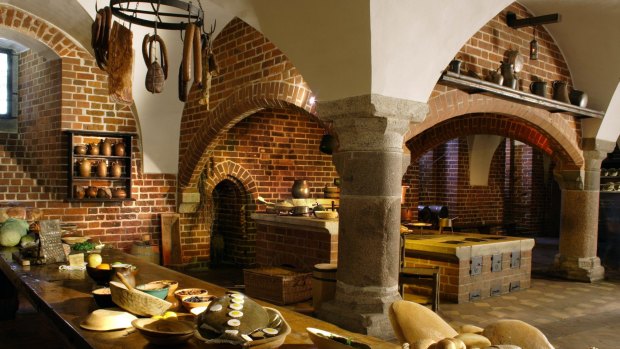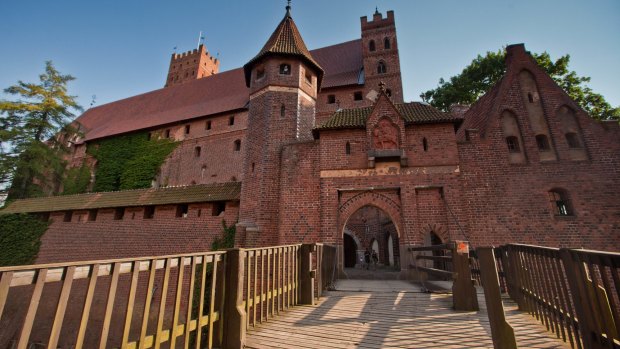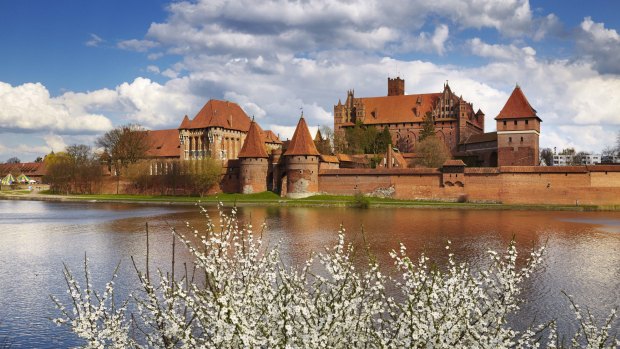This was published 5 years ago
Poland's 13th century Malbork Castle has an amazing restaurant inside
By Tim Richards

Former kitchens within Malbork Castle, Poland.
"I'm the only chef in the world to have my own restaurant in a medieval castle."
It's a big boast, but a fair one, as chef Bogdan Galazka's turf is the Gothic Cafe & Restaurant within Poland's 13th century Malbork Castle.
Not that he sticks to medieval recipes. Having lived and worked in New York City, Galazka combines New World techniques with the traditional cuisine of Central Europe, partly inspired by dishes once served to the Teutonic Knights who ruled here.

Malbork Castle is the world's largest brick castle. Credit: Polish Tourism Organisation
He's emerged from the kitchen at the end of a delicious meal to deliver a dessert that's an unconventional delight: a confection of white chocolate, sesame seeds, halva, blackcurrant sauce and fruit, served in a glass inside a small pink cage.
Outside the restaurant, however, things seem less light-hearted as I take a guided tour of Malbork, the world's largest brick castle and a symbol of the historic rivalry between the Germanic knights and the former Kingdom of Poland. Spread out along the Nogat River, its scarred brick-red bulk dominates the city beneath it and hints at the many battles it has seen.
The most recent of these occurred in 1945, as the castle was massively damaged during the last days of World War II. Nowadays, however, the edifice receives the care it deserves as a UNESCO World Heritage site, and makes for a great day trip from the nearby city of Gdansk.

Malbork Castle was only saved from demolition in the 19th century when sketches of it were exhibited in Berlin. Credit: Polish Tourism Organisation
My local guide, Krzysztof, leads me first to the Great Refectory, where the knights once ate. Closed to the public for many years due to rotting foundations, it was reopened in 2007 after repairs. It's a grand, light-filled space, with vaulted ceilings and high Gothic-pointed windows.
Next is the palace of the Teutonic Knights' ruler, the Grand Master, from where he would plan new conquests across the region. The entrance hall here has an elaborate ceiling decoration featuring grapevines, a symbol of Christianity and a link with the Middle East where the knights had joined the Crusades.
Not that Malbork has always been so well respected. In the 18th century, says our guide, the Prussian government established a tannery in the Summer Refectory, and the castle was only saved from demolition in the 19th century when sketches of it were exhibited in Berlin.
In earlier centuries the threats to Malbork, known in German as Marienburg, came via attack rather than neglect. The most famous attempt on the castle was by the Polish army, which besieged it for two months in 1410. Though this assault was unsuccessful, it's remembered each July as the Siege of Malbork, a lively three-day re-enactment involving costumed knights, crossbows and archers.
A souvenir of the original siege is a cannonball lodged in the upper wall of the Summer Refectory, thought to have been left there by the knights as a reminder.
There are many more interesting areas to see, each a mix of original materials and sensitive restoration. Within them are collections of amber and weaponry, likenesses of significant Grand Masters, displays of old cooking tools, and sacred statuary. There's even the original toilet tower, marked by an anachronistic gargoyle.
At the more elegant end of the scale is St Mary's Church, the most important place of worship to the knights and fully restored only in 2016. It has the one original medieval door in the castle, and battle damage is still evident on the pitted brick walls.
It is, however, very beautiful, with candles and sunlight softly illuminating its Gothic arches and faded images of saints. It's a curiously gentle haven within a building designed for war.
TRIP NOTES
FLY
Emirates and LOT fly to Gdansk, from where Malbork can be reached by train. See emirates.com and rozklad-pkp.pl
STAY
Hotel Centrum has affordably-priced accommodation near Malbork Castle, from $80 a night. See hotelmalbork.pl
Qubus Hotel is a stylish place to stay in central Gdansk, from $75 a night. See qubushotel.com
VISIT
Entry to Malbork Castle costs $15 from May to September, $11 from October to April and includes an English self-guided audio tour, on request. See zamek.malbork.pl
For the Gothic Cafe & Restaurant's current menu and contact details, see gothic.com.pl
MORE
Tim Richards travelled courtesy of Poland's Ministry of Foreign Affairs.
Sign up for the Traveller Deals newsletter
Get exclusive travel deals delivered straight to your inbox. Sign up now.